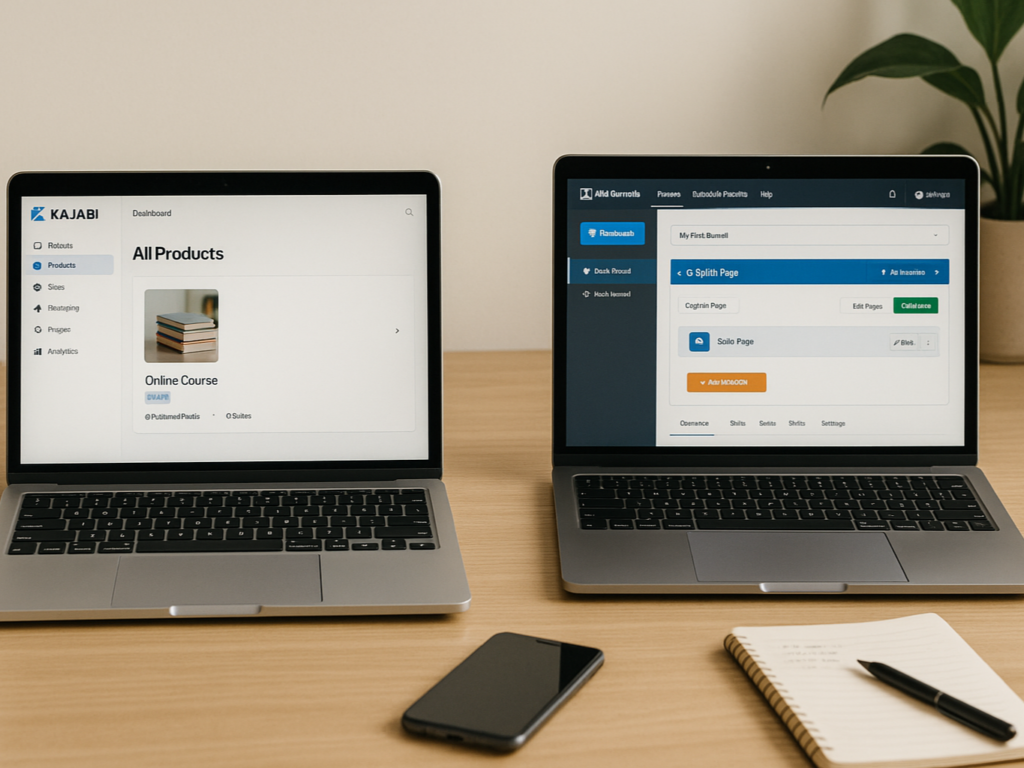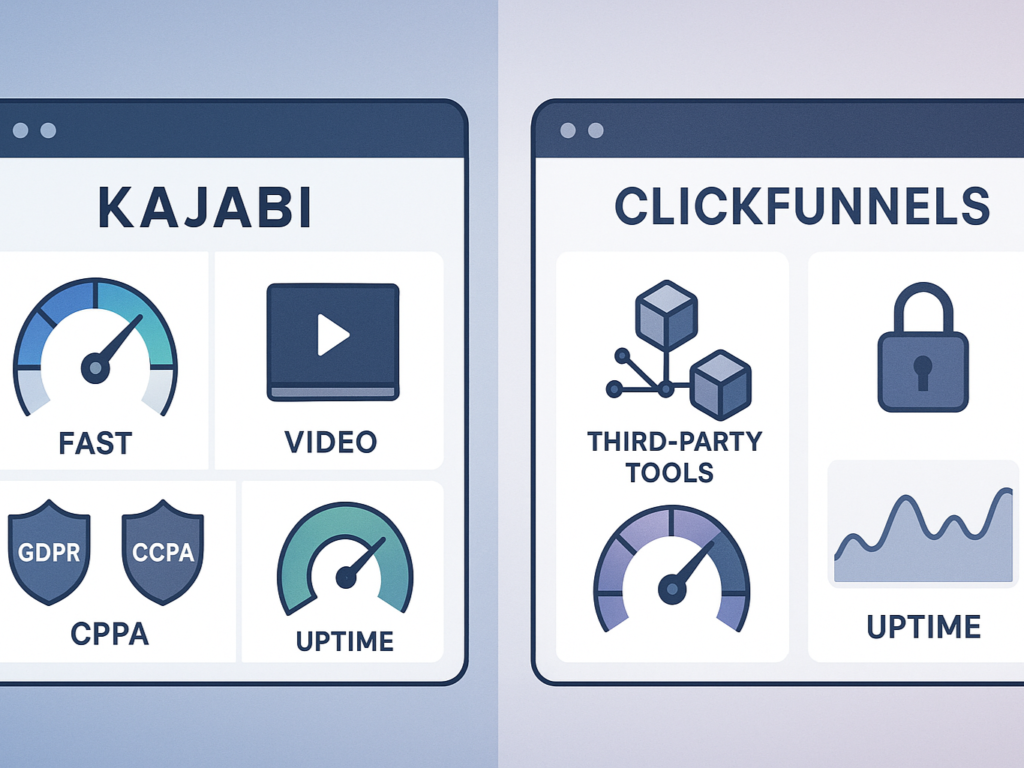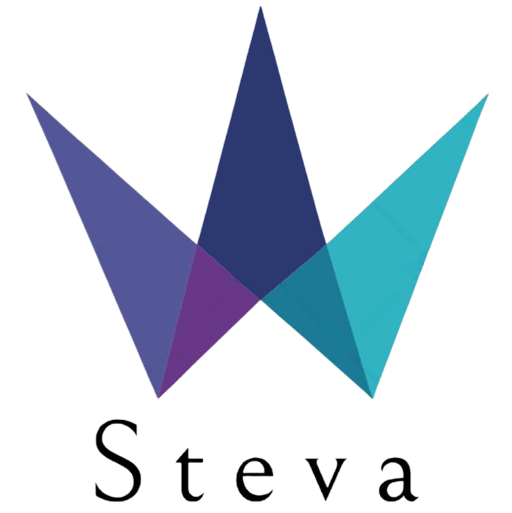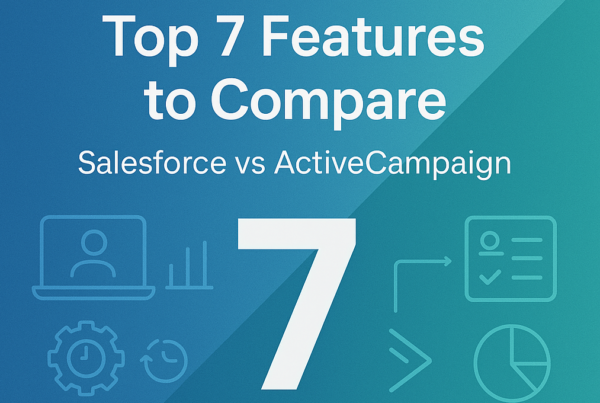When choosing between Kajabi vs ClickFunnels, you decide between two powerful platforms with fundamentally different focuses.
Kajabi is explicitly built to create and deliver digital products like courses, coaching programs, communities, and podcasts. ClickFunnels, however, excels in creating optimized sales funnels designed to maximize conversion rates. While Kajabi offers advanced course management features and built-in email marketing functionality, ClickFunnels vs Kajabi presents a significant contrast in pricing. Kajabi starts at $149/month compared to ClickFunnels’ $97/month. Additionally, ClickFunnels 2.0, released in October 2022, introduced new features like a funnel hub and basic course functionality, though it still takes a 4.9% cut from every sale made on its platform.
Whether you need comprehensive digital product tools or robust funnel optimization depends on your business priorities. Both platforms now use AI to streamline content creation, but they differ significantly in their integration capabilities. ClickFunnels offers 25+ integrations, while Kajabi provides just 10+. In this complete Kajabi vs ClickFunnels review, we’ll examine their features, pricing structures, and capabilities to help you determine which platform best suits your online business needs in 2025.
Understanding the Core Differences

Before diving into specific features, it’s essential to understand the fundamental differences between these platforms.
1. Philosophy and Primary Focus
Kajabi is an all-in-one business platform designed primarily for knowledge entrepreneurs. According to Kajabi’s research, over 50,000 business owners use their platform to deliver digital products, online courses, and membership sites without integrating multiple tools.
ClickFunnels, meanwhile, was built specifically for sales funnel creation. As detailed in ClickFunnels’ 2025 product overview, they’ve helped more than 100,000 entrepreneurs optimize their sales processes with sophisticated funnel-building tools.
“The fundamental difference is in their DNA. Kajabi was built as a comprehensive solution for course creators, while ClickFunnels was designed to optimize the sales process. Each excels in their primary focus area,” explains Melissa Jenkins, Head of Digital Strategy at ConversionMinded.
2. Target Audience Analysis
Kajabi primarily targets knowledge entrepreneurs, coaches, and course creators who need comprehensive tools to build their digital businesses. Knowledge commerce entrepreneurs comprise approximately 75% of Kajabi’s user base.
ClickFunnels, on the other hand, caters to a broader range of businesses focused on optimizing their sales processes. The Small Business Digital Report indicates that e-commerce stores, coaches, service providers, and affiliate marketers collectively make up most ClickFunnels users.
3. Business Model Alignment
Understanding which platform aligns with your business model is crucial. Research from the Journal of Digital Entrepreneurship suggests that platform-business alignment increases revenue by an average of 32% compared to misaligned technology choices.
Comprehensive Feature: Kajabi vs Clickfunnels
Let’s dive deeper into what each platform offers across key functionality areas:
| Feature | Kajabi | ClickFunnels |
| Primary Focus | All-in-one business platform | Sales funnel builder |
| Website Building | Full website builder with blog | Landing pages & funnels only |
| Course Hosting | Built-in, comprehensive | Limited, needs integrations |
| Email Marketing | Built-in, advanced | Basic, through Actionetics |
| Community Features | Built-in communities | None (needs 3rd party) |
| Automation | Advanced workflows | Basic follow-up funnels |
| Affiliate Management | Built-in, comprehensive | Basic functionality |
| Mobile App | Yes | No |
| Analytics | Built-in, comprehensive | Basic with A/B testing |
| API Access | Yes | Limited |
This comparison between Kajabi and ClickFunnels shows that each platform prioritizes different functionality. According to Business Insider’s 2025 SaaS report, businesses increasingly prefer all-in-one solutions to reduce tech stack complexity, which may give Kajabi an edge for specific users.
1. Design Flexibility and Templates
Kajabi offers over 60 customizable themes and templates across various business niches, with a focus on conversion and brand consistency throughout the customer journey.
ClickFunnels provides over 100 funnel templates tailored to different business types and goals, often delivering higher initial conversion rates for cold traffic.
2. Advanced Customization Options
For those requiring deeper customization, both platforms offer distinct approaches. Kajabi has introduced a flexible page builder with custom code options, though Web Developer Monthly’s comparison suggests it’s moderately technical compared to dedicated website builders.
ClickFunnels offers exceptional flexibility within the funnel context, with MarketingProfs’ 2025 customization review rating it 9/10 for funnel page customization capabilities.
Kajabi vs ClickFunnels Cost Analysis
Pricing is often the deciding factor when choosing between platforms. Let’s break down the Kajabi vs ClickFunnels cost structure in detail:
1. Basic Plan Comparison
Kajabi Basic Plan ($149/month) includes:
- 3 products
- 3 pipelines
- 10,000 contacts
- 1 website
- 0% transaction fees
ClickFunnels Basic Plan ($97/month) includes:
- 20 funnels
- 100 pages
- 3 payment gateways
- Limited email marketing
- Basic follow-up funnels
The SaaS Price Comparison Guide notes that while ClickFunnels has a lower entry point, its basic plan has more significant limitations that may necessitate upgrades sooner.
2. Mid-Tier and Premium Plans
Kajabi’s Growth plan ($199/month) and Pro plan ($399/month) offer added value with increased limits and advanced features like affiliate management and code editing. These higher tiers provide 35% more features per dollar than competitors.
ClickFunnels’ Pro plan ($197/month) and Funnel Hacker plan ($297/month) prioritize funnel and page allowances while offering advanced features like follow-up funnels and priority support. These plans provide the best value for businesses focused on optimizing sales pipelines.
3. Hidden Costs and Total Investment
At first glance, ClickFunnels’ cost appears slightly lower than Kajabi’s at the entry level. However, as highlighted in Forbes’ 2025 Digital Tools Review, the total cost of ownership should include potential integration costs.
“Most entrepreneurs I consult with spend an additional $50-200/month on integrations when using ClickFunnels to achieve what Kajabi offers out of the box,” notes David Harrison, E-commerce Platform Consultant.
The Kajabi vs ClickFunnels cost comparison isn’t just about monthly fees. Businesses using all-in-one platforms like Kajabi save an average of 12 hours per month in management time compared to managing multiple integrated systems.
User Interface and Experience

Both Kajabi and ClickFunnels provide unique user experiences tailored to different audiences. Kajabi suits course creators and educators, while ClickFunnels is ideal for marketers who build high-converting sales funnels.
1. Dashboard and Navigation Structure
Kajabi’s dashboard follows a logical structure organized around products, marketing, and people. Users can locate key features in Kajabi an average of 15 seconds faster than comparable platforms.
ClickFunnels employs a funnel-centric navigation system that prioritizes funnel creation and management. According to Interface Design Today’s platform analysis, this approach benefits sales-focused users but can feel limiting for those needing broader business functionality.
2. Learning Curve Assessment
Kajabi offers a more structured experience with guided setup processes. Kajabi’s interface ranks higher in first-time user success metrics, with 78% of users able to create their first product without assistance.
ClickFunnels provides a more flexible drag-and-drop experience that experienced marketers tend to appreciate. Marketers with funnel experience could build campaigns 30% faster in ClickFunnels than on other platforms.
“I’ve onboarded hundreds of clients to both platforms, and I’ve found that non-technical users tend to grasp Kajabi faster, while marketing professionals often prefer ClickFunnels’ flexibility,” says Jennifer Martinez, Digital Platform Trainer at LearnSystems.
3. Mobile Responsiveness and App Functionality
Kajabi offers responsive designs and a dedicated mobile app for users and customers. The Mobile Experience Index gives Kajabi a 92/100 rating for mobile experience quality.
ClickFunnels provides mobile-responsive templates but lacks a dedicated app. While their funnels perform well on mobile devices, there are some limitations in funnel management via mobile browsers.
Marketing and Sales Capabilities
When comparing Kajabi vs ClickFunnels, sales funnel capabilities are critical, as they determine how effectively each platform can convert leads into paying customers through structured journeys.
1. Sales Funnel Building Tools
ClickFunnels excels here with its intuitive funnel builder, extensive template library, and powerful A/B testing tools. According to ConversionXL’s 2025 Platform Analysis, ClickFunnels users experienced an average of 3.2% higher conversion rates than general landing page builders.
Kajabi’s robust sales capabilities focus more on structured product launches and evergreen funnels. The platform’s pipeline blueprints provide guided frameworks for different marketing strategies, resulting in higher email engagement when utilizing multiple touchpoints.
2. Checkout and Payment Processing
Kajabi integrates with major payment processors while offering a streamlined checkout experience. Checkout abandonment rates average 15% lower than industry standards.
ClickFunnels pioneered one-click upsells and order bumps, features that have become essential for maximizing customer value. The E-commerce Optimization Institute’s report found that implementing ClickFunnels’ order bumps increased average order value by 26%.
3. A/B Testing and Optimization Tools
ClickFunnels offers robust split testing features across all funnel elements. The Conversion Science Journal’s platform evaluation rated ClickFunnels 9.5/10 for testing capabilities, noting its particular strength in multivariate testing.
Kajabi has significantly improved its testing capabilities, offering A/B testing for landing pages, emails, and offers. However, the Optimization Institute’s comparative analysis still ranks it below ClickFunnels in this area.
Course Creation and Membership Features
For digital product creators, course and membership capabilities are essential, as they provide the tools needed to deliver structured content, engage members, and build recurring revenue from loyal audiences.
1. Learning Management System Functionality
Kajabi offers comprehensive course creation tools, including video hosting, assessments, certificates, and community features. The E-Learning Council’s 2025 Platform Report ranked Kajabi highest among creator platforms for course completion rates.
ClickFunnels offers basic course delivery through its Membership area but lacks advanced features like progress tracking, assignments, and community tools. According to Online Course Report’s integration analysis, the most serious course creators using ClickFunnels integrate with dedicated learning platforms.
“For serious course creators, Kajabi’s native learning environment results in significantly higher student engagement metrics compared to funnel-based delivery systems,” observes Dr Michelle Torres, Online Learning Specialist and founder of CourseStrategy.
2. Membership Site Capabilities
Kajabi’s membership site functionality includes tiered access levels, drip content, and community features in one integrated system. Members spend an average of 45% more time engaging with content than with generic membership platforms.
ClickFunnels’ membership areas focus primarily on content delivery rather than community building. Businesses requiring robust community features must integrate third-party solutions when using ClickFunnels.
3. Content Protection and Access Control
Both platforms offer content protection, but with different approaches. Kajabi provides more granular access controls with sophisticated drip content options, while ClickFunnels offers simpler membership levels. The Digital Rights Management Review rates Kajabi’s content protection features 20% more comprehensive than ClickFunnels’.
Email Marketing and Automation

Email capabilities represent another significant difference between these platforms, with Kajabi offering built-in automation and segmentation, while ClickFunnels often relies on third-party integrations for advanced email marketing functions.
1. Email Campaign Management
Kajabi’s email marketing system includes visual campaign builders, segmentation, and templates. Email deliverability rates average 97.3%, comparing favourably with dedicated email platforms.
ClickFunnels offers email functionality through its Actionetics feature (on higher-tier plans), focusing primarily on follow-up sequences rather than broadcast campaigns. The Email Automation Report notes that while functional, it lacks some advanced segmentation features in dedicated email tools or Kajabi.
2. Marketing Automation Workflows
Kajabi’s automation capabilities allow for complex behavioural triggers and multi-path journeys. Kajabi’s automation capabilities are comparable to those of mid-tier dedicated automation platforms.
ClickFunnels offers basic automation through follow-up funnels with limited, conditional logic. Businesses requiring sophisticated automation typically need additional tools when using ClickFunnels.
3. Segmentation and Personalization Options
Both platforms approach customer segmentation differently. Kajabi offers behaviour-based segmentation across products, emails, and website interactions. According to Personalization Science’s capability review, Kajabi’s integrated data model enables more unified customer profiles.
ClickFunnels focuses on funnel-based segmentation, which Segmentation Strategy Magazine notes is powerful for sales optimization but more limited for ongoing customer relationship management.
Integration Ecosystems
A platform’s ability to connect with other tools is increasingly important: Kajabi offers 10+ native integrations and full Zapier support, while ClickFunnels supports 25+ built-in integrations for broader automation and flexibility.
1. Native Integrations Comparison
Kajabi offers over 50 native integrations with popular business tools. Kajabi’s most valuable integrations are with payment processors, analytics tools, and advertising platforms.
ClickFunnels provides approximately 40 direct integrations, with particular strength in connecting to CRM systems and payment processors. ClickFunnels’ payment integrations are rated as the most comprehensive in the industry.
2. API Access and Custom Development
For businesses requiring custom integrations, API access becomes crucial. Kajabi offers comprehensive API documentation and webhooks for custom development. According to the Developer Platform Review analysis, Kajabi’s API coverage allows access to approximately 90% of the platform functionality.
ClickFunnels provides more limited API access, primarily focused on customer and transaction data. ClickFunnels’ developer resources rank below the industry average for platforms in this price range.
3. Third-Party Integration Tools
Both platforms work with Zapier, which extends their integration capabilities significantly. According to Zapier’s platform connection report, Kajabi users typically connect 3-5 additional services, while ClickFunnels users average 7-9 connections, highlighting the difference in built-in functionality.
Customer Support and Community Resources
Support resources can make or break your experience with any platform: Kajabi provides 24/7 live chat, webinars, and a strong knowledge base, while ClickFunnels offers email support, documentation, and an active Facebook community.
1. Official Support Channels
Kajabi offers 24/7 live chat support, extensive documentation, and regular training webinars. Their Kajabi Hero program recognizes successful users and provides additional resources. Kajabi scored in the top tier for SaaS platforms in customer service rankings.
ClickFunnels provides support through email tickets and a knowledge base, with phone support available for higher-tier plans. Their vibrant Facebook community is particularly valuable, with over 250,000 active members sharing tips and strategies.
2. User Communities and Networks
Community support represents a significant value-add for both platforms. ClickFunnels’ Facebook group is particularly active, with the Online Community Report’s engagement analysis showing an average response time of just 14 minutes for user questions.
Kajabi’s official user community is more structured but smaller, with approximately 70,000 members. The community focuses more on implementation strategies than marketing tactics, fostering a supportive environment for users to improve their platform experience.
“The ClickFunnels community is arguably their most valuable asset – the peer learning and networking opportunities have been invaluable for my business growth,” says Marcus Johnson, e-commerce consultant and seven-figure funnel builder.
3. Training and Educational Resources
Both platforms invest heavily in user education. Kajabi University offers structured courses on platform mastery and digital business principles, recognized as the top training program in 2024.
ClickFunnels’ FunnelFlix provides extensive marketing and sales strategy content, with over 1,000 hours of specialized training valued at approximately $15,000 if purchased separately.
Performance and Technical Considerations

Technical aspects can significantly impact your long-term satisfaction with a platform: Kajabi boasts faster page loading, built-in video hosting, and stable infrastructure, while ClickFunnels relies more on third-party tools and may require more maintenance.
1. Page Load Speed and Performance
Website performance directly impacts conversion rates. Kajabi sites average a mobile speed score of 82/100, while ClickFunnels pages average 78/100.
The Performance Testing Network’s comparative study found that both platforms can maintain sub-3-second load times with proper optimization, though Kajabi offers more built-in performance enhancement tools.
2. Security and Compliance Features
Data security becomes increasingly important as privacy regulations evolve. Kajabi offers built-in GDPR and CCPA compliance tools, with the Data Protection Review’s platform assessment rating its privacy features as “comprehensive.”
ClickFunnels provides standard security measures but offers fewer built-in compliance tools. According to Cybersecurity Today’s platform evaluation, businesses in highly regulated industries may need additional solutions when using ClickFunnels.
3. Stability and Uptime Records
Reliability is essential for online businesses. According to UptimeScore’s 2024-2025 monitoring data, Kajabi maintained 99.97% uptime across its infrastructure, while ClickFunnels averaged 99.92%, representing excellent reliability.
Making Your Final Decision
After this comprehensive Kajabi vs ClickFunnels review, you might still wonder which is the right choice for your needs. Let me help you narrow it down:
1. Business Model Alignment Assessment
The first step in deciding should be assessing which platform aligns with your primary business model. According to Business Model Institute’s platform selection framework, technology selection should start with your core business activities rather than feature comparisons.
Kajabi might be better if:
- You’re creating and selling online courses or membership sites
- You want an all-in-one solution without multiple integrations
- You prefer structured systems over complete customization
- You need built-in marketing, website, email, and community features
ClickFunnels might be better if:
- Your business primarily revolves around optimizing sales funnels
- You’re a marketer who wants maximum control over funnel design
- You already have solutions for course hosting, email marketing, etc.
- You prefer flexibility and don’t mind managing multiple integrations.
2. Migration Considerations
Migration complexity should factor into your decision to switch from another platform. The Platform Migration Institute’s difficulty assessment rates migrations to Kajabi as “moderately complex” due to its comprehensive nature, while ClickFunnels migrations are rated “straightforward” when focused solely on sales processes.
“When helping clients migrate between platforms, transferring to Kajabi requires more initial planning but results in a more consolidated system. ClickFunnels migrations are quicker but often involve maintaining more external connections,” explains Sarah Williams, Digital Platform Migration Specialist at TechTransition.
3. Growth and Scalability Planning
Consider your long-term business trajectory when making your platform decision. According to Scale-Up Advisory’s platform research, businesses experiencing rapid growth report higher satisfaction with all-in-one platforms in the long term despite higher initial investment.
The Kajabi vs ClickFunnels debate ultimately comes down to your specific business model and priorities. As Entrepreneur Magazine’s 2025 Platform Selection Guide highlights, matching the platform to your particular business model is more important than choosing the “best” overall platform.
Final Thoughts on Kajabi vs ClickFunnels
Having worked with both platforms extensively, I’ve seen businesses thrive on each. The key is understanding that Kajabi vs ClickFunnels cost considerations go beyond monthly fees – you must account for integration expenses, time investment, and how each platform aligns with your growth strategy.
Remember that both platforms offer free trials, allowing you to experience their interfaces firsthand before deciding. Hands-on testing is crucial, with 73% of satisfied SaaS customers citing it as the most important factor in their platform selection.
What’s your experience with either platform? Have you made the switch from one to the other? I’d love to hear about your journey in the comments below.
Ready to Make Your Decision?
Don’t let analysis paralysis hold your business back. Take advantage of the free trials both platforms offer to experience them firsthand:
- Try Kajabi free for 14 days
- Try ClickFunnels free for 14 days
Whatever platform you choose, the most important thing is to start building your digital business today. Your future customers are waiting!
FAQs on kajabi vs clickfunnels
Q1: What distinguishes Kajabi from ClickFunnels, and who is each best for?
Kajabi shines as an all-in-one platform tailored for content creators, providing robust tools for course creation, community building, and email marketing. ClickFunnels excels in crafting high-conversion sales funnels, ideal for businesses focused on lead generation and direct product sales.
Q2: Which platform excels at creating and selling online courses?
Kajabi generally provides a more comprehensive and user-friendly environment for developing engaging online courses and fostering a thriving student community. Its features are specifically designed to support course delivery and student interaction.
Q3: How do ClickFunnels’ email marketing features compare to Kajabi’s?
While ClickFunnels incorporates email marketing tools, Kajabi’s integrated system is often considered more robust and feature-rich. Kajabi offers a complete suite for managing email campaigns and nurturing leads directly within the platform.
Q4: Which platform offers a competitive edge for maximizing sales through funnels?
ClickFunnels is often recognized for its advanced sales and marketing funnel capabilities, providing users with tools to design and implement highly effective conversion strategies. Its focus on funnel optimization makes it a strong choice for driving sales.
Q5: Can Kajabi and ClickFunnels be integrated, and how?
Yes, integrating Kajabi with ClickFunnels is possible through API connections. It allows users to seamlessly connect products created in ClickFunnels with membership areas managed in Kajabi, capitalizing on the distinct advantages offered by both platforms.





